Weevils in Flour (Flour Bugs): Causes and Treatments
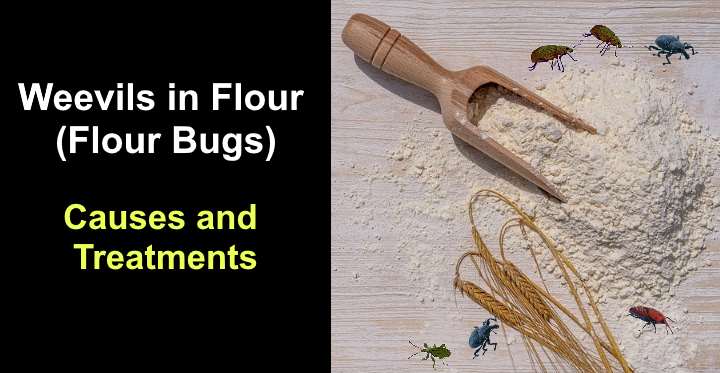
Finding weevils in flour and other pantry staples can give you a nasty surprise. The little critters that look like tiny black dots love to infest dry foodstuffs in your pantry. Unfortunately, discovering weevils in flour probably means the bugs have laid eggs and hatched into larvae, ready to become more adult weevils.
Getting rid of flour weevils is challenging. Therefore, preventing the weevil bugs from getting into your cereals, flour, rice, and cake mixes is vital to get rid of flour weevils for good. However, it’s also important to know how to identify types of tiny beetles that can live in flour and other pantry goods.
This article helps you identify weevils in flour and how the tiny critters get into your house. Additionally, you’ll find helpful tips on how to get rid of flour bugs for good.
What Is a Flour Weevil?
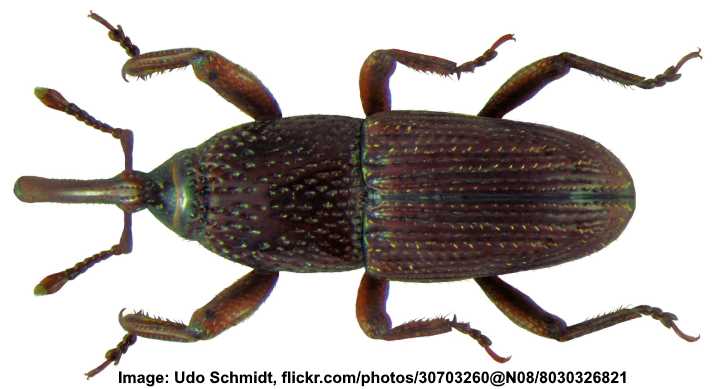
Granary weevil (Sitophilus granarius) is a type of flour weevil and is identified by a brown body with ridges and long snout
Flour weevil refers to several types of long-snouted beetles that infest pantry foodstuffs. Also called flour bugs, the tiny brown or black weevils multiply rapidly and spread throughout stored cereals, rice, cornmeal, dry mixes, and flour. The pantry pests also lay eggs in flour that hatch into larvae.
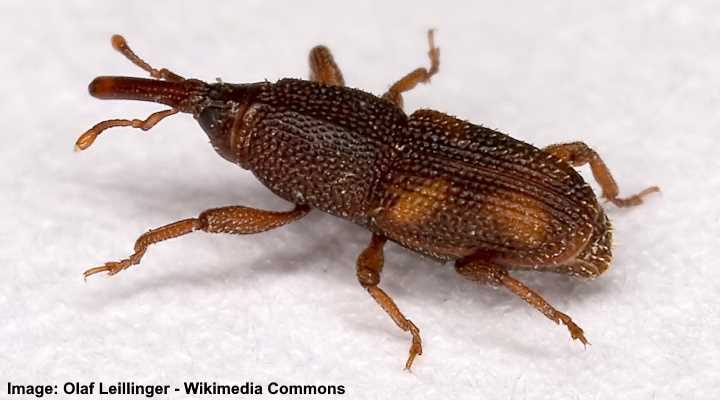
The rice weevil (Sitophilus oryzae) is a type of small brown beetle identified by its elongated snout
Weevils are small reddish-brown beetles belonging to the insect genus Sitophilus. Common types of weevils you may find in pantries are granary weevils (Sitophilus granarius), rice weevils (Sitophilus oryzae), and maize weevils (Sitophilus zeamais).
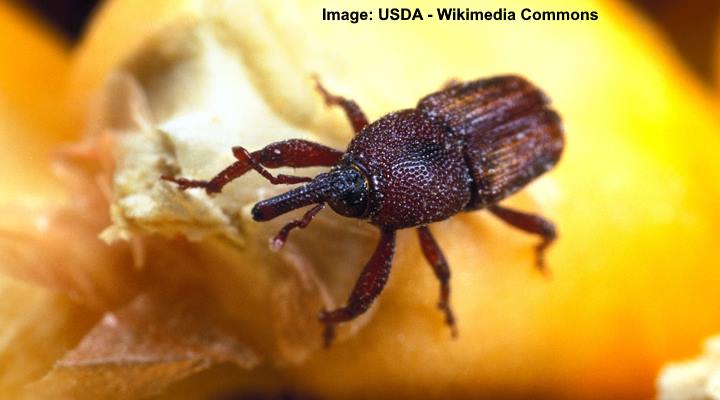
The brown maize weevils (Sitophilus zeamais) are cabinet bugs that infest dried cereal products
The flour weevil could also refer to the red flour beetle (Tribolium castaneum). Although related, the red flour beetle isn’t a type of weevil. It is a reddish-brown oval beetle but lacks the distinctive long snout that sets weevils apart from regular beetles.
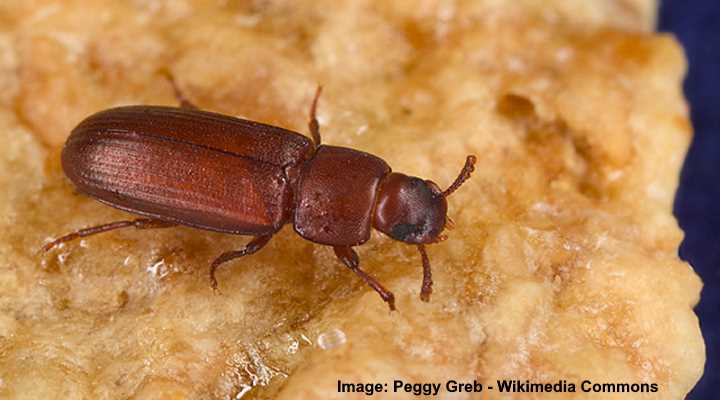
Red flour beetle (Tribolium castaneum)
Whether the little bugs in flour are a type of weevil or the red flour beetle, they are pesky insects that shouldn’t be in your food products.
How to Identify Weevils in Flour
Weevils in flour are easily identified by their slender oval bodies, elongated head, six legs, and characteristic long thin snout. The reddish-brown flour bugs measure 0.12” to 0.20” (3 – 5 mm). Unfortunately, many species of pantry weevils look alike, and it can be difficult to tell them apart.
Trying to identify weevil eggs and larvae in flour is nearly impossible. The microscopic eggs are undetectable to the naked eye, and the larvae or little white grubs are difficult to spot. This is because weevils lay eggs in kernels or compacted flour, where the larvae hatch and pupate.
Signs of Flour Weevil Infestation
There are several tell-tale signs if pesky weevils have infested flour and other grain products. First, their dark reddish bodies make them stand out against white flour. However, the chances are you will notice signs of weevil activity in flour before you see the tiny bugs crawling in your dry, stored foodstuffs.
Here are some signs that you must take action to rid your pantry of nasty weevils:
Silky webs in packets of flour
Cobwebs dangling from cereal and flour packets are among the most common signs of weevils in flour. You may notice that the silky, sticky webs have small clumps of flour stuck to them. If you notice strange bits in flour packets, it is time to throw the product in the trash.
Flour bug carcasses
Weevils can live a long time in flour and other stored dry foods—especially if you rarely use flour. Therefore, you may notice evidence of molted skin, dead weevils, or even tiny black spots (which are feces) in flour.
Strange smell from flour
Weevil-infested flour may give off a funky aroma. While flour can go bad, an “off” smell from the packet could indicate weevil activity. The bad smell comes from pantry bug feces and dead carcasses. If you suspect weevils have infested your flour, throw it out and check other stored cereals in your cupboards.
Adult weevils in flour
Seeing tiny blackish critters crawling in flour is an obvious sign of flour bug activity. Due to the contrast with plain white flour, they will be easy to spot. However, adult flour weevils will be harder to detect in wholegrain flour.
How Do Weevils Get Into Flour?
Weevils typically get into flour during production or from nearby infested foodstuffs in your pantry. Unlike typical beetles, female weevils lay eggs inside the wheat kernel. And despite the processing, the eggs can survive in flour and find their way into your home, where they hatch, pupate, and grow into nasty pantry bugs.
Flour Bug Life Cycle
The life cycle of a typical weevil lasts around 28 days. First, the female lays an egg in a grain kernel or compacted flour that hatches after three days. Next, the larva feeds on the kernel for two and a half weeks and then pupates for six days. After that, the adult weevil emerges through a small hole.
Adult female weevils can live for up to five months and produce 250 to 400 eggs.
What Do Flour Weevils Eat?
Weevils that infest pantries feed on any type of stored grain products. This is why you will often find granary weevils or rice weevils in flour, beans, cereals, seeds, cornmeal, and nuts. In addition, you may find that wholegrain cereals infested with weevils have empty kernels. This is because female weevils lay eggs inside the grains.
Are Flour Weevils Harmful?
Weevils are not harmful to humans. They do not bite, sting, or spread disease. However, they can cause a good deal of damage to stored foodstuffs in your pantry. Once inside cupboards, weevils can quickly begin feeding on stored grains and pantry foods.
Can you eat flour that has weevils in it? While eating products contaminated with weevils is unlikely to cause harm, it could cause you to feel unwell. So, it’s not recommended. In addition, infested flour, grain, and rice products can contain weevil feces and dead bodies—hardly something appetizing. Therefore, if you find weevils in flour, it’s best to deal with the infestation immediately.
Suppose you have accidentally used infested flour in cooking. In that case, you don’t need to panic. The boiling, frying, or baking process will kill any live weevils and bugs, making the food safe to eat.
How To Get Rid of Flour Weevils
Despite being common pests, reddish-brown flour bugs have no place in a pantry. So, you should take quick action to rid your cupboards of any foods showing signs of weevil activity. After that, it’s important to prevent the nasty critters from returning.
Please read on to find out how to get rid of weevils in flour.
Discard Infested Foodstuffs
If you notice signs of weevils in flour, you should trash the packet in a sealed plastic bag. This will prevent the bugs from escaping and infesting nearby foodstuffs. Although flour bugs are typically in flour, they can live in packets of crackers, cereals, pasta, and grains.
If you notice weevils in a packet of flour, it’s good to check other stored food in your pantry. Therefore, inspect the packets of all foods to look for signs of pantry bug activity. The most common thing to look for is silky webs with small clumps of food stuck to them.
Discard any suspected food items to ensure no further contamination.
Freeze Flour, Cereals, and Grains Where Weevils Live
You can freeze newly purchased packets of flour to prevent them from being infested with weevils. First, put the packet of flour or grain in a resealable plastic bag. Then place in the freezer for a week. Freezing flour will kill any existing bugs, ensuring they don’t multiply in your bag of flour.
If you suspect there are dead weevils after removing the flour from the freezer, you could sieve it. This will ensure that any carcasses don’t end up in the flour.
Clean Pantry Shelves
Unfortunately, discarding weevil-infested flour and other foods doesn’t necessarily solve the issue. Removing all stored items from pantry shelves and thoroughly cleaning them is vital. To eliminate traces of weevil eggs or larvae, use a vacuum to remove bits of food or flour from shelves.
The next step in eradicating weevils from your pantry is to wash all surfaces. For this, hot, soapy water will be sufficient. All you must do is use a soapy sponge or cloth to wipe down shelves and countertops. Then wipe the surfaces dry.
Use Vinegar Solution to Kill Flour Weevils
Use a vinegar spray as an effective and natural way to get rid of flour weevils from pantries. Mix equal parts of water and white vinegar in a spray bottle to make a vinegar flour bug spray. Spray the solution on shelves and surfaces and leave it to dry. The pungent vinegar smell will soon disappear.
Vinegar has acidic qualities that help to kill any existing bugs and larvae lurking in nooks and crannies. Also, studies have shown that apple cider vinegar has several antimicrobial properties that kill certain types of food pathogens like E. coli.
How to Prevent Flour Weevils
The best way to stop weevils from infesting flour is to prevent them in the first place. Here are several steps to prevent flour bug infestations in your pantry:
Store Dry Foods in Airtight Containers
Storing food in glass or airtight plastic containers is the best way to prevent bugs in flour. Pantry bugs like grain beetles or rice weevils cannot chew through hard plastic or glass. And if the jars are sealed correctly, there is little chance of them breaking through.
It’s good to remember that weevils and house beetles can easily chew through cardboard boxes, paper bags, and even thin plastic. Therefore, the habit of transferring stored foodstuffs to hard containers with airtight lids will stop all kinds of bugs from feasting on your pantry items.
Some people store flour, rice, oats, and other grains in the freezer. This is useful if you rarely use these products in cooking. In addition, the low temperature and humidity in the sealed environment keep pesky weevils away from your food.
Inspect Food Before Storing in Your Pantry
A vital way to prevent weevils in flour or other grain items is to inspect food before storing them in your pantry. Flour bugs typically get into homes in products you buy in the store. Therefore, always open packets to inspect for signs of weevil activity. Throw the food out if you notice any suspicious reddish-brown specks or silky webs.
Use Natural Flour Bug Repellents
Natural repellents can help to prevent food-infesting critters from spoiling your pantry. For example, the scent of some herbs and spices can be enough to send pantry bugs the other way. Some natural bug repellents include crushed bay leaves, cloves, and garlic. You can place these items on shelves and replace them once a month.
Research suggests that compounds in bay leaves are an effective beetle repellent. Also, essential oils in cloves have insect-repelling properties. In addition, garlic and black pepper compounds can act as a natural repellent against red flour beetles.
It’s good to remember that storing flour in airtight containers is the best way to prevent weevils. However, using natural repellents can give cupboards a nice scent and help keep flour bugs at bay.
Avoid Buying in Bulk
If weevils are a problem in your pantry, consider buying smaller amounts of flour. Try only to buy what you need for a month or so. This way, you minimize the risk of weevils laying eggs, hatching, and growing into adults.
Of course, it’s possible to save money by buying in bulk. So if this is necessary for you, always inspect the food you buy and store it in suitable weevil-proof containers.
Types of Weevils You Can Find in Food
There are three primary types of weevils you may find in flour and other stored products in your pantry.
Rice Weevil (Sitophilus oryzae)
The adult rice weevil is a brownish-black beetle which measures 0.12” to 0.17” (3 – 4.5 mm) long. The little flour bug has a slender body, a characteristic long, slender snout, and several orange spots on its back. In addition to infesting rice products, you can also find this weevil in maize and wheat foodstuffs.
Rice weevils are one of the few pantry bugs that fly. Adult females can live four to five months and lay up to 400 eggs in their lifetime.
Granary Weevil (Sitophilus granarius)
Also called the wheat weevil or grain weevil, this small oblong beetle measures 0.12” to 0.20” (3 – 5 mm) long. The small flour bug has a reddish-brown to black body, six legs, and chewing mouthparts. However, it doesn’t have such a long snout compared to the rice weevil.
Adult granary weevils feed on flour and whole seeds. The female adult can lay eggs in flour—but only in compacted flour. The female beetles make a protective chamber for the egg—similar to a hollow kernel. The pesky weevils are active throughout the year and easily survive in typical household temperatures.
Maize Weevil (Sitophilus zeamais)
The maize weevil looks like a larger version of the rice weevil. Also called the greater rice weevil, this reddish-brown flour bug grows 0.09” to 0.19” (2.3 – 5 mm) long. Its relatively large oval body has reddish-yellow markings on the wing covers. Like the rice weevil, this beetle can fly.
Like most pantry bugs, the maize weevil feeds on various stored grains like wheat, oats, rye, and barley. The pesky flour bugs also lay eggs in compacted flour, cereal kernels, and pasta products.
Related articles:
